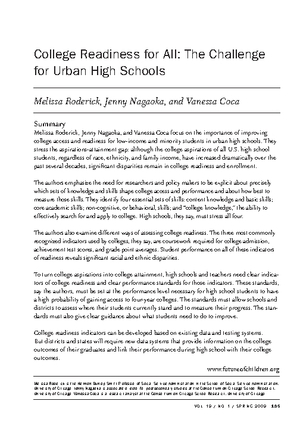What exactly does college readiness entail? And how can high schools best promote it? In this article, we address those questions by examining different definitions of college readiness and laying out the challenges that a focus on college readiness presents to high school reform. We begin by addressing racial and ethnic and income disparities in college readiness and enroll- ment among the nation’s high school stu- dents. Next we explore the different types of skills and knowledge that students need to do well in college, what indicators can be used to assess these skills, and how different bench- marks of college readiness shape the concep- tion of what the policy problem is. Finally, we discuss what policy strategies may best promote a focus on college readiness in high schools.
Melissa Roderick, Jenny Nagaoka, and Vanessa Coca focus on the importance of improving college access and readiness for low-income and minority students in urban high schools. They stress the aspirations-attainment gap: although the college aspirations of all U.S. high school students, regardless of race, ethnicity, and family income, have increased dramatically over the past several decades, significant disparities remain in college readiness and enrollment.
The authors emphasize the need for researchers and policy makers to be explicit about precisely which sets of knowledge and skills shape college access and performance and about how best to measure those skills. They identify four essential sets of skills: content knowledge and basic skills; core academic skills; non-cognitive, or behavioral, skills; and “college knowledge,” the ability to effectively search for and apply to college. High schools, they say, must stress all four.
The authors also examine different ways of assessing college readiness. The three most commonly recognized indicators used by colleges, they say, are coursework required for college admission, achievement test scores, and grade point averages. Student performance on all of these indicators of readiness reveals significant racial and ethnic disparities.
To turn college aspirations into college attainment, high schools and teachers need clear indicators of college readiness and clear performance standards for those indicators. These standards, say the authors, must be set at the performance level necessary for high school students to have a high probability of gaining access to four-year colleges. The standards must allow schools and districts to assess where their students currently stand and to measure their progress. The standards must also give clear guidance about what students need to do to improve.
College readiness indicators can be developed based on existing data and testing systems. But districts and states will require new data systems that provide information on the college outcomes of their graduates and link their performance during high school with their college outcomes.
From the Future of Children, a collaboration of the Woodrow Wilson School of Public and International Affairs at Princeton University and the Brookings Institution.



